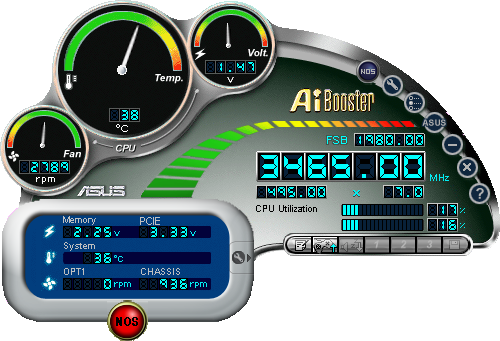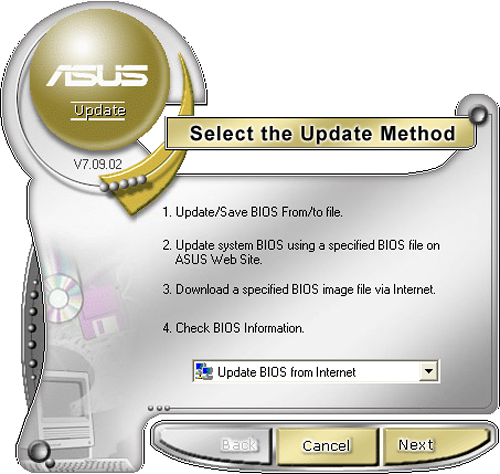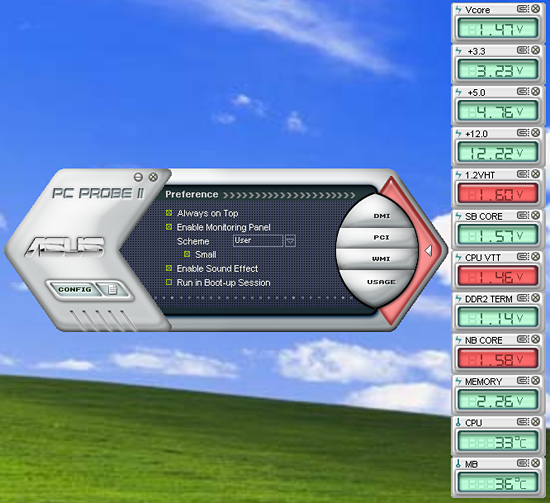ASUS P5N32-E SLI Plus: NVIDIA's 650i goes Dual x16
by Gary Key on April 2, 2007 3:30 AM EST- Posted in
- Motherboards
Specifications and Basic Features
The latest ASUS BIOS offers a very good level of options that are available for tweaking the board with specific emphasis placed on the available memory settings. We found in memory testing that switching to manual settings and changing the tCAS, tRCD, tRP, and tRAS was required to ensure optimum performance.
Compared to the 680i LT board, the number of voltage options and range of changes are extensive but the lack of GTL Ref voltage settings limited our quad core overclocking results to 360 FSB but the board was able to reach benchmark stable FSB speeds of 495 with our dual core processors.
One other issue we have with the 0402 and 0602 BIOS releases is that memory sub timings are very tight, especially tRC rates which ended up causing stability issues with some of our lower cost memory modules with ProMOS or Elpida ICs. While the aggressive memory timings allow for optimum performance, we generally had to hand tweak them to ensure stability across a wide range of memory modules.



ASUS offers minimum support for NVIDIA's nTune system utility but includes several proprietary programs for tweaking and monitoring the board. The AiBooster utility offers the ability to tweak FSB speeds and certain voltages along with monitoring basic temperatures, fan speeds, and voltages. This utility allows the user to fine tune the AI NOS program that detects system load and dynamically increases system performance up to 10%. We were able to set NOS at 10% and complete our benchmark suite without issues. However, when using the AI Overclock option in the BIOS, we were unable to get the fixed 20% setting stable during benchmarking and had to back off to 15%.
Also included is the ASUS Update program that allows for BIOS updates within Windows from the ASUS FTP site (or from your hard disk if the BIOS was already downloaded). We have not had any issues recently when updating our BIOS with the ASUS Update program, but we still prefer the DOS floppy method. The ASUS PC Probe II utility is one of the better manufacturer supplied programs for tracking voltage settings, fan speeds, and basic temperatures. We still believe abit's µGuru technology offers the best combination of tweaking and monitoring capabilities in a supplier provided program, but ASUS's AiSuite is certainly capable enough for most users.
| ASUS P5N32-E SLI Plus | |
| Market Segment: | High-End Performance - $185 |
| CPU Interface: | Socket T (Socket 775) |
| CPU Support: | LGA775-based Pentium 4, Celeron D, Pentium D, Pentium EE, Core 2 Duo, Core 2 Extreme |
| Chipset: | NVIDIA 650i SPP (C55) + 570 SLI MCP (MCP55P) |
| Bus Speeds: | Auto, 533 to 3000 QDR (133~750) in 1MHz increments |
| Memory Ratios: | Auto, Sync., 1:1, 5:4, 3:2 |
| Memory Speed: | 400MHz~2600MHz in various increments |
| PCIe 1-2-3 Speeds: | 100MHz~200MHz in 1MHz Increments |
| LDT Frequency: | 1x, 2x, 3x, 4x, 5x, 6x, 7x, 8x |
| Core Voltage: | Auto, 0.83125V to 1.90000 in 0.00625V increments |
| FSB Options: | Optimal, Linked, Unlinked |
| CPU Clock Multiplier: | Auto, 6x-11x in 1X increments - Core 2 Duo, downwards unlocked, Core 2 Extreme 6x-50X |
| DRAM Voltage: | Auto, 1.8500V to 3.4250 in .025V increments |
| DRAM Timing Control: | Optimal, Manual - 13 DRAM Timing Options |
| NB Voltage: | Auto, 1.20V to 2.75V in .05V increments |
| 1.2V HT Voltage: | Auto, 1.20V to 1.95V in .05V increments |
| SB Voltage: | Auto, 1.50V to 1.85V in .05V increments |
| CPU VTT: | Auto, 1.20V to 1.55V in .05V increments |
| Memory Slots: | Four 240-pin DDR2 DIMM Slots Dual-Channel Configuration, DDR2-400, 533, 667, 800 Regular Unbuffered Memory to 8GB Total |
| Expansion Slots: | 2 - PCIe X16 (2-x16 electrical for SLI or Multi-GPU) 1 - PCIe X16 (x8 electrical) 1 - PCIe x1 2 - PCI Slot 2.2 |
| Onboard SATA/RAID: | 6 SATA 3Gbps Ports - 570 SLI MCP (RAID 0, 1, 0+1, 5, JBOD) |
| Onboard IDE: | 1 ATA133/100/66 Port (2 drives) - 570 SLI MCP |
| Onboard USB 2.0/IEEE-1394: | 10 USB 2.0 Ports - 4 I/O Panel - 6 via Headers 2 Firewire 400 Ports by VIA 6309P - 1 I/O Panel, 1 via Header |
| Onboard LAN: | NVIDIA Gigabit Ethernet - PCIe - 2 x Marvell 88E1116 PHY - 2 ports via 570 SLI MCP |
| Onboard Audio: | ADI 1988B - 8-channel HD audio codec, Supreme FX audio card |
| Power Connectors: | ATX 24-pin, 8-pin EATX 12V |
| I/O Panel: | 1 x PS/2 Keyboard 1 x PS/2 Mouse 1 x S/PDIF Optical - Out 1 x S/PDIF Coaxial - Out 1 x IEEE 1394a 2 x RJ45 4 x USB 2.0/1.1 |
| Auto Overclocking: | AI Overclock - 5%10%, 15%, 20% Fixed; N.O.S. - 3%, 5%, 8%, 10% Variable |
| BIOS Revision: | Award 0602 |
| Board Revision: | v1.0 |
The latest ASUS BIOS offers a very good level of options that are available for tweaking the board with specific emphasis placed on the available memory settings. We found in memory testing that switching to manual settings and changing the tCAS, tRCD, tRP, and tRAS was required to ensure optimum performance.
Compared to the 680i LT board, the number of voltage options and range of changes are extensive but the lack of GTL Ref voltage settings limited our quad core overclocking results to 360 FSB but the board was able to reach benchmark stable FSB speeds of 495 with our dual core processors.
One other issue we have with the 0402 and 0602 BIOS releases is that memory sub timings are very tight, especially tRC rates which ended up causing stability issues with some of our lower cost memory modules with ProMOS or Elpida ICs. While the aggressive memory timings allow for optimum performance, we generally had to hand tweak them to ensure stability across a wide range of memory modules.



ASUS offers minimum support for NVIDIA's nTune system utility but includes several proprietary programs for tweaking and monitoring the board. The AiBooster utility offers the ability to tweak FSB speeds and certain voltages along with monitoring basic temperatures, fan speeds, and voltages. This utility allows the user to fine tune the AI NOS program that detects system load and dynamically increases system performance up to 10%. We were able to set NOS at 10% and complete our benchmark suite without issues. However, when using the AI Overclock option in the BIOS, we were unable to get the fixed 20% setting stable during benchmarking and had to back off to 15%.
Also included is the ASUS Update program that allows for BIOS updates within Windows from the ASUS FTP site (or from your hard disk if the BIOS was already downloaded). We have not had any issues recently when updating our BIOS with the ASUS Update program, but we still prefer the DOS floppy method. The ASUS PC Probe II utility is one of the better manufacturer supplied programs for tracking voltage settings, fan speeds, and basic temperatures. We still believe abit's µGuru technology offers the best combination of tweaking and monitoring capabilities in a supplier provided program, but ASUS's AiSuite is certainly capable enough for most users.










37 Comments
View All Comments
JarredWalton - Monday, April 2, 2007 - link
Sorry - just an errant typo correction. If you look at the image, you can see it's 1T. Gary had "TT" in there and I corrected that to 2T when it should have been 1T.yacoub - Monday, April 2, 2007 - link
oh awesome :)mostlyprudent - Monday, April 2, 2007 - link
I think it's time for a comprehensive article to pick the best boards for Intel CPUs (P965 vs. 680i vs. 650i vs. 680i LT vs. 975X vs. RD600, etc.). I know some of this has been done in pieces, but it would sure be nice to have it all in one article. Please :)Gary Key - Monday, April 2, 2007 - link
After I finally complete the opus known as uATX or "How to kill the reviewer", we will have a performance roundup that might even include a new spin of the P35. ;-)yacoub - Monday, April 2, 2007 - link
It'd be awesome to see a round-up in time for the April 22nd Intel price drop and 6320/6420 release.I want to know simply: "The Best 650 SLI and 680 SLI NVidia-based Boards For 6320/6420 OverClocking" and NOT with any of that ridiculously over-priced Dominator or Flex XLC RAM. Just test with realistic RAM that actual people would buy like Corsair XMS2 or OCZ Platinum series and similar. High-end RAM but not retarded over-priced stuff with gigantic cooling mechanisms. Test RAM that's around $250 (or less) for 2GB matched pairs.
That's what I'd like to see. An actual overclocker 650/680 board round-up for the 6320/6420 c2d chips with RAM people who are looking for the best bang-for-the-buck would actually buy.
People who spend around $200-250 for the motherboard, $200-250 for quality, low-latency RAM, and $200 for the CPU.
There's a lot of us and we'd love to know which board to buy and which RAM works best with it when oc'ing.
sWORDs - Tuesday, April 3, 2007 - link
The OCZ2N1066SR2GK only costs €208 here, that's SLI ready, 1066 MHz, 5-5-5-15, 2x 1GB.The OCZ2N900SR2GK only costs €192 here, that's SLI ready, 900 MHz, 4-4-3-15, 2x 1GB.
yacoub - Monday, April 2, 2007 - link
This image link on page4 is different than the actual image:http://images.anandtech.com/reviews/motherboards/a...">http://images.anandtech.com/reviews/mot...sus/p5n3...
http://images.anandtech.com/reviews/motherboards/a...">http://images.anandtech.com/reviews/mot...sus/p5n3...
(I think one of the sample images is duplicated.)
JarredWalton - Monday, April 2, 2007 - link
Did someone fix this? They are definitely different images for me, although only minor differences.Marlowe - Monday, April 2, 2007 - link
Very nice review - looks like a good board! After reading the article I have some questions:Isn't the 'Plus' moniker ment to mean some kind of functionality with Vista? I think I remember when some previous Asus board got a new revision and the got the Plus moniker, it also got a small PCB riser board attached below the IO area.. ReadyBoost or something? Does this board have that? It's not that copper square behind the LAN/USB connections? Or maby it's just a new name for their mid-range boards.
Isn't that a 6-phase power circuit in the pics? I know the Asus site claims 8-phase, but they also have a wrong power circuit pic. The site also says "With the highest speed up to 800MHz," about the memory speed and doesn't mention support for EPP at all, so that must be wrong as well according to your article?
In the expansion slot area you write "two PCI Express x1" but that's not so? Isn't the top slot for the "SupremeFX" audio riser board?
In the Dual Core OC page, the E6300 has 2MB L2 not 4MB :)
And a question: I have the Tuniq120 as well, and the fan is placed ~7 cm over the board and placed in an angle so I guess there aren't much airflow going to those heatpipe sinks. Did you have to use an additional fan over the cpu area while using the Tuniq120 heatsink and overclocking? So if overclocking you *have* to hang some fan with zip ties or something over that area? Thats a bit of a hassle isn't it :P
Anyways very nice performing board :D Looks physically totally identical to the Asus P5N32-E SLI tho :D But
sWORDs - Tuesday, April 3, 2007 - link
The E Plus is ment as an upgrade to the E, it has all solid caps just as the Striker.The E, E Plus and Striker all use the same PCB (just look under the white sticker) and all have a 8 phase power design.
All three have EPP and SLI Ready support up the 1200 (and the 1250 works as well).
The top one can only be used for the riser.
True.
The Northbridge does get very hot, however using the heatpipes should be enough to reach 450. Any busspeed above 400 isn't recommended anyway because of the reduction of timing from the strap selection.
True, they share the same PCB, this one has the same caps as the Striker.